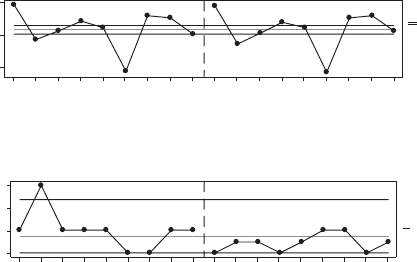
200 Six Sigma Case Studies with Minitab
®
The graph in Figure12.8 shows the
X
___
values of the two operators. The
averages of the
X
___
values are joined with straight lines. Notice that, for each
part, the
X
___
values of the two operators are very close. Hence, this graph
also means that the reproducibility of the measurement system is good. The
graph in Figure12.9 too shows that the average diameters of all the parts for
the two operators are almost equal. (Notice that the line joining the averages
of the two operators is almost horizontal.) Hence, this graph too shows that
the reproducibility of the measurement system is good.
The graph in Figure12.10 is essentially an overlap of the
X
___
charts (shown in
Figure12.7) of the two operators. Because the charts are almost parallel, it means
that there is no signicant interaction between the parts and the operators.
Figures12.11 and 12.12 are excerpts from the session output. Inasmuch as
the default value for “alpha to remove interaction term” in the dialog box
shown in Figure12.5 is 0.25 and the P-value for part and operator interaction
in Figure12.11 is 0.649 (>0.25), Minitab
®
has repeated an ANOVA without the
interaction term (see Figure12.12).
In Figure 12.12, the P-value for Part is 0.00 (<0.05), and the P-value for
Operator is 0.153 (>0.05). It is evident from this output that the variation in
the diameters is due to the differences among parts and not due to variation
between operators.
Figures 12.13 and 12.14 are also excerpts from the session output. It is
clear from the “%Contribution” values (variance values) in Figure 12.13
that just 1.39% of the variation in the diameters is due to variation in gage
987654321987654321
0.0006
0.0004
0.0002
0.0000
Part
Sample Range
R = 0.0001444
UCL = 0.0004719
LCL = 0
12
987654321987654321
9.014
9.012
9.010
Part
Sample Mean
12
UCL = 9.012627
X = 9.012356
LCL = 9.012084
Gage name:
Da
te of study:
XYZ Calipers
03/19/2012
Reported by: John Doe
Tolerance:
Misc:
R Chart by Operator
Xbar Chart by Operator
ABC Project
FIGURE 12.7
Xbar and R charts.

201Measurement System Analysis at a Medical Equipment Manufacturer
987654321
9.014
9.013
9.012
9.011
9.010
9.009
Part
Gage name:
Da
te of study:
XYZ Calipers
03/19/2012
Reported by: John Doe
Tolerance:
Misc:
Diameter by Part
ABC Project
FIGURE 12.8
Diameter by part.
21
9.014
9.013
9.012
9.011
9.010
9.009
Operator
Gage name:
Da
te of study:
XYZ Calipers
03/19/2012
Reported by: John Doe
Tolerance:
Misc:
Diameter by Operator
ABC Project
FIGURE 12.9
Diameter by operator.

202 Six Sigma Case Studies with Minitab
®
repeatability and gage reproducibility. Note that 1.30% for repeatability and
0.08% for reproducibility are not adding up to 1.39% due to rounding. Whereas
“% Contribution” in Figure12.13 measures contribution to variance of the data,
“% Study Var” in Figure12.14 measures contribution to standard deviation of
the data.
Notice that none of the graphs in Figures12.6–12.10 shows the individual
part diameters for each trial for each operator. A gage run chart can be used
to show those data. Figure12.15 shows how to plot a gage run chart. Doing so
opens the dialog box shown in Figure12.16. As shown in Figure12.16, select
“Part” for “Part Numbers”, “Operator” for “Operators”, and “Diameter” for
987654321
9.014
9.013
9.012
9.011
9.010
Part
Average
1
2
Operator
Gage name:
Da
te of study:
XYZ Calipers
03/19/2012
Reported by: John Doe
Tolerance:
Misc:
Part* Operator Interaction
ABC Project
FIGURE 12.10
Interaction between part and operator.
Two-Way ANOVA Table with Interaction
Source DF SS MS F P
Part 8 0.0000448 0.0000056 373.407 0.000
Operator 1 0.0000000 0.0000000 2.667 0.141
Part * Operator 8 0.0000001 0.0000000 0.750 0.649
Repeatability 18 0.0000004 0.0000000
Total 35 0.0000453
Alpha to remove interaction term = 0.25
FIGURE 12.11
ANOVA with interaction.

203Measurement System Analysis at a Medical Equipment Manufacturer
“Measurement Data”. Click on the “Gage Info” button, and the dialog box
shown in Figure12.17 opens. Enter the information as shown in Figure12.17
and click on “OK”. It takes you back to the dialog box shown in Figure12.16.
Click on the “Options” button and the dialog box shown in Figure 12.18
opens. Enter the title as shown in Figure12.18 and click on “OK”. It takes you
back to the dialog box shown in Figure12.16. Click on “OK” and the gage run
chart shown in Figure12.19 results. It is clear from the gage run chart that the
repeatability of each operator is good and also the reproducibility between
the two operators is good.
StudyVar %StudyVar
Source StdDev (SD) (6*SD) (%SV)
Total Gage R&R 0.0001402 0.0008412 11.79
Repeatability 0.0001359 0.0008152 11.42
Reproducibility 0.0000346 0.0002075 2.91
Operator 0.0000346 0.0002075 2.91
Part-To-Part 0.0011814 0.0070883 99.30
Total Variation 0.0011897 0.0071380 100.00
FIGURE 12.14
Distribution of standard deviations.
Two-Way ANOVA Table without Interaction
Source DF SS MS F P
Part 8 0.0000448 0.0000056 303.394 0.000
Operator 1 0.0000000 0.0000000 2.167 0.153
Repeatability 26 0.0000005 0.0000000
Total 35 0.0000453
FIGURE 12.12
ANOVA without interaction.
%Contribution
Source VarComp (of VarComp)
Total Gage R&R 0.0000000 1.39
Repeatability 0.0000000 1.30
Reproducibility 0.0000000 0.08
Operator 0.0000000 0.08
Part-To-Part 0.0000014 98.61
Total Variation 0.0000014 100.00
FIGURE 12.13
Distribution of variances.
Get Six Sigma Case Studies with Minitab® now with the O’Reilly learning platform.
O’Reilly members experience books, live events, courses curated by job role, and more from O’Reilly and nearly 200 top publishers.

